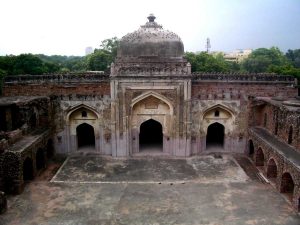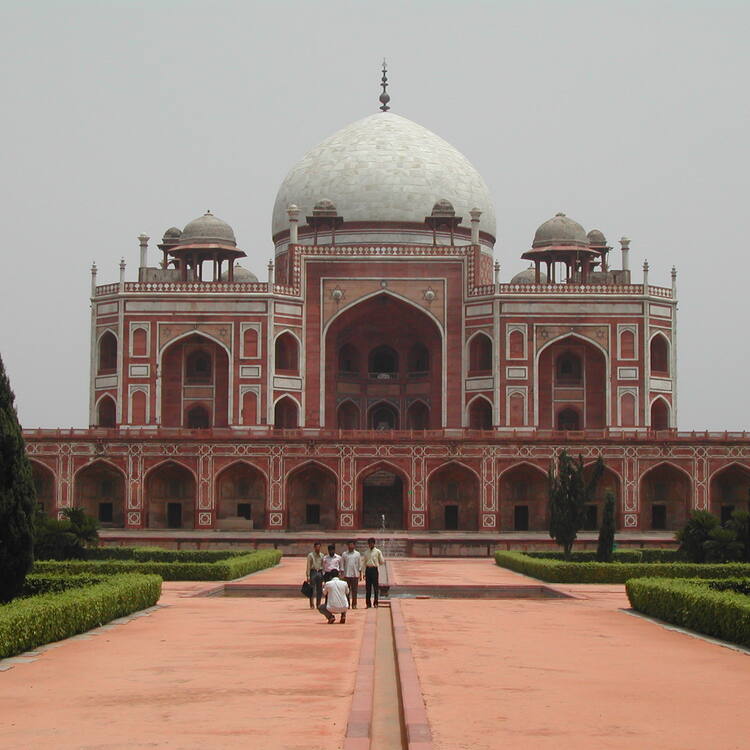The arrival of Muslim rule in the late 12th century brought together two significant architectural styles. Over time, this resulted in a greater synthesis and fusion of the best elements from both traditions, leading to the creation of some of the most stunning Indo-Islamic structures in the Indian subcontinent. Mosques and mausoleums became the focal points of Islamic architecture in India.
Characteristic features of Indo-Islamic form of architecture
Below are the Characteristic features of Indo-Islamic form of architecture:
- Indo-Islamic buildings were constructed using brick, lime, and mortar.
- The predominant style was arcuate, which utilized arches, domes, and vaults.
- Islamic art avoided human figurines and instead used geometric patterns such as arabesques, floral motifs, and various styles of inscriptions. Inlay on marble, or pietra dura, was also popular.
- Buildings often featured ornamental, perforated lattice screens with arabesques, star motifs, and geometric shapes such as pentagons, hexagons, octagons, and circles.
- Gardens played a significant role in Islamic architecture.
Styles of Islamic architecture in the Indian subcontinent
Imperial Style
Also known as the early Indo-Islamic style, this period saw the conversion of existing buildings into mosques, incorporating elements of ruins from Hindu temples. The palaces were intricately decorated with arches, domes, and Hindu motifs such as floral patterns.
Provincial Style
This style of architecture spanned over two hundred and fifty years, during which buildings were constructed using locally available materials and combining regional styles with Muslim features such as domes, arches, minarets, and mihrabs. Initially, they used the ruins of Hindu and Jain temples, but later they developed their own unique style of building art.
Mughal Style
The Mughal style of architecture flourished in India under the patronage of the Mughal Empire during the mid-16th to the 17th century. It is a fusion of Indo-Islamic, Persian, and Turkish influences, resulting in buildings that are remarkably symmetrical and uniform in pattern, with intricate ornamentation.
Types of buildings in Islamic architecture in the Indian subcontinent
Mosques
- Mosques, also known as "masjids", serve as places of congregation for Muslim men during prayer.
- They often feature hypostyle halls and may include attached Madrasahs.
- The mihrab, a niche indicating the direction of Mecca, is an important element in mosque architecture.
- Minarets, towers adjacent or attached to mosques, are used to announce the call to prayer.
- Domes, also known as "qubba", and calligraphy are commonly used decorative elements in mosques.
Forts
- Forts were built on a larger scale than palaces and served as a city within a city for the monarchs and their people.
- Their primary purpose was defense against enemies.
- Regional influences can be seen in the construction of forts, particularly in Gujarat and Punjab.
Tombs
- The Taj Mahal, a white domed marble structure surrounded by large gardens, pools with fountains, and four tall minarets, is a prime example of the Indo-Islamic style of architecture.
- It represents a balanced and symmetrical form and is an architectural accomplishment of Mughal building art.
- Mumtaz Mahal's tomb is just one of many beautiful structures built during the Islamic reign in India.
Evolution of this form of architecture during the medieval period
Delhi Sultanate
- Arrival of Turks brought new architectural styles from Persia, Arabia, and Central Asia.
- Engineering features such as domes, arches, and minarets were incorporated into palaces, mosques, and tombs built by rulers.
- Indigenous architecture was blended with new techniques, resulting in a new synthesis.
- Examples include Quwwatul Islam Mosque, Qutub Minar, Hauz Khas, tombs of Mohammad Tughlaq and Firoz Tughlaq, and forts of Tughlaqabad.

Regional Kingdoms
- Regional kingdoms in Bengal, Gujarat, and Deccan developed their own architectural styles.
- Examples include Jama Masjid, Sadi Saiyyad Mosque, and shaking towers at Ahmadabad, Jama Masjid, Hindola Mahal, and Jahaz Mahal in Mandu, and Gol Gumbaz at Bijapur.
- Bengal's distinctive features include oblong structures and peculiar roof construction.
- In Jaunpur, Atala mosque had a gigantic screen covering the dome, while the tomb of Hoshang Shah at Malwa is entirely made of marble with inlay work.
- Bahamani sultans borrowed from styles of Persia, Syria, Turkey, and temples of Southern India.
Mughals
- Mughals introduced a new era in architecture, reaching the zenith of Indo-Islamic architecture.
- Examples include Humayun’s Tomb, forts at Agra and Fatehpur Sikri, Buland Darwaza, tomb of Salim Chishti, Palace of Jodha Bai, Ibadat Khana, and Birbal’s House at Fatehpur Sikri.
- Shahjahan was the greatest builder among the Mughals, using marble extensively with decorative inlay work, arches, and minarets.
- Examples include Red Fort, Jama Masjid, and the Taj Mahal.
- Taj Mahal reflects all architectural features developed during Mughal period, including central dome, minarets, gateway, inlay work, and gardens.
- Mughal style influenced later period architecture with courtyards, pillars, and sculpted living beings.


